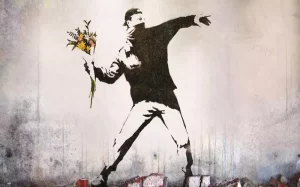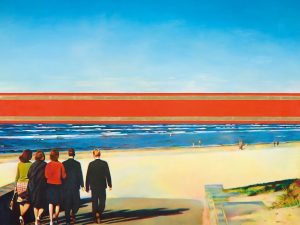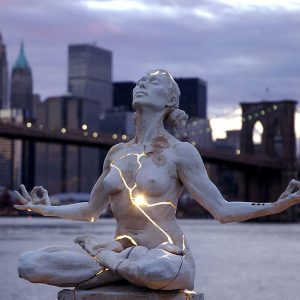
Public art is a form of art that is accessible to the general public and often displayed in public spaces. It encompasses a wide range of media, including sculptures, murals, installations, monuments, and paintings. Public art can be displayed in a variety of locations such as parks, squares, streetscapes, or even on the sides of buildings. It can serve a variety of purposes, such as creating a sense of community identity, commemorating important events or figures, or providing a visual representation of shared values or beliefs. Public art can also be used to educate viewers about social issues and encourage civic engagement. No matter the purpose, public art has the power to transform public spaces into vibrant, inspiring places. Public art has the ability to inspire and bring people together. It can encourage conversation, create connections between communities and cultures, spark creativity, and promote a sense of pride in where we live. Public art often reflects a city’s values and celebrates its history by memorializing important figures or events. By displaying public art, cities can demonstrate their commitment to cultivating a vibrant culture and celebrating the diversity of their citizens. Additionally, public art can bring an economic boost to a city; when done well, it attracts tourists and encourages businesses to move in. In this way, public art can help foster more prosperous communities. Public art is an integral part of city life and provides us with a greater sense of place. By bringing people together to appreciate art, cities become more unified and connected. Public can also be used to make about social issues, allowing citizens to express their opinions and influence public policy through the visual arts. Ultimately, public art has the power to bring communities closer together and foster civic engagement.

art in the public interest
Art in the public interest is an important part of many cities’ cultural and artistic landscapes. It can provide a powerful platform for expressing shared values and creating a sense of community identity. Public art can also be used to educate viewers about social issues, foster civic engagement, and encourage creative thinking.
Public art has become increasingly popular in recent years, as cities seek to add a unique flair to their streetscapes. Public art can come in many forms such as sculptures, murals, installations, monuments, and paintings. By displaying public art in prominent locations like parks or squares, cities demonstrate their commitment to encouraging creativity and celebrating diversity.
Public art is often funded by local governments, businesses, and philanthropic organizations. This helps to ensure that it is accessible to all members of the community regardless of their socio-economic status or background.
Public art can often serve multiple purposes beyond simply providing visual appeal. It can be used to commemorate important events or figures, promote civic engagement and dialogue, or provide a unique representation of shared values and beliefs.
Public art has the potential to transform public spaces into vibrant, inspiring places. By bringing people together to appreciate art, cities become more unified and connected. It can also be used to start conversations about social issues and encourage citizens to express their opinions through the visual arts. Ultimately, public art in the public interest can help build strong, prosperous communities.
Public art has the power to bring people together and foster civic engagement in ways that are meaningful and creative. It is a way for cities to show their commitment to encouraging creativity and celebrating diversity, while also providing citizens with a greater sense of place. By displaying public art in prominent locations, cities can demonstrate their commitment to cultivating a vibrant culture and open dialogue.
By bringing people together to appreciate art, cities become more unified and connected. Public art has the power to transform public spaces into vibrant, inspiring places that foster civic engagement and encourage creative thinking. It can be used as an effective tool for educating citizens about social issues, allowing them to express their opinions and influence public policy through the visual arts. Ultimately, public art has the power to bring communities closer together and foster a greater sense of belonging.
street art sculptures

Street art sculptures are a unique form of public art that can be found in cities around the world. Street art sculptures often feature vibrant colors and bold designs, adding a unique flair to city streetscapes. These sculptures can come in many forms such as murals, installations, monuments, and paintings. Street art sculptures can serve multiple purposes, from commemorating important events or figures to promoting civic engagement and dialogue. By displaying distinctive public art, cities can demonstrate their commitment to encouraging creativity and celebrating diversity.
Street art sculptures can a powerful platform for expressing shared and creating a sense of identity. They can also be as an effective tool for educating viewers about social issues and fostering civic engagement. Street art sculptures are increasingly becoming popular as cities around the world look to add a unique flair to their streetscapes. By displaying colorful and bold public art, cities can show their commitment to cultivating vibrant cultures and open dialogue.
Overall, street art sculptures have the potential to transform public spaces into vibrant, inspiring places. By bringing people together to appreciate art, cities become more unified and connected. Moreover, street art sculptures are an effective way for citizens to express their opinions and influence public policy through the visual arts. Ultimately, street art can help build strong, prosperous communities by encouraging creativity and promoting civic engagement.
In conclusion, street art sculptures are an incredibly powerful form of public art. They have the potential to transform public spaces into vibrant, inspiring places that foster civic engagement and encourage creative thinking. By displaying distinctive public art, cities can demonstrate their commitment to encouraging creativity and celebrating diversity. Street art sculptures can also be used as an effective tool for educating citizens about social issues and allowing them to express their opinions and influence public policy through the visual arts. Ultimately, street art in the public interest can help build strong, prosperous communities.
